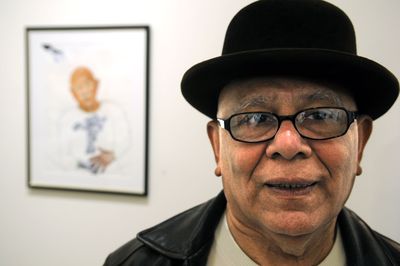Nationally admired artist Ruben Trejo dies
Mexican heritage key in work

The art world in Eastern Washington and across the country is mourning the loss of a premier Mexican-American artist and educator whose originality took him all the way to the Smithsonian Institution, despite his humble beginnings.
Ruben Trejo, professor emeritus at Eastern Washington University, died Sunday at Providence Holy Family Hospital from myelodysplastic syndrome, a blood disorder.
He was renowned across the country, and his work is part of the permanent collections of the Smithsonian American Art Museum, the National Hispanic Cultural Center in Albuquerque, N.M., and the National Museum of Mexican Art in Chicago. He worked in a number of mediums, including sculpture, mixed-media installations, painting and drawing.
“A major American artist is gone,” said Tomas Ybarra-Frausto, a prominent Hispanic art scholar in New York.
“Ruben is just an absolute jewel,” said Sue Bradley, owner of Tinman Gallery on the North Side where Trejo earlier this year exhibited his “Border Series” show as part of a national tour.
“He had a wonderful sense of humor,” Bradley said. “He was extremely intelligent. He was very much an idea person.”
Trejo, 72, was born in St. Paul, Minn., in a railroad car that was used to house rail laborers. His father worked for the railroad and his mother was an illegal alien given immunity by President Dwight D. Eisenhower. He was one of 11 children, two of whom survive him.
As a boy, he lived with migrant farmworker relatives and for a time with his grandmother in Mexico.
He earned his bachelor’s and master’s degrees from the University of Minnesota and joined Eastern Washington University in fall 1973. He co-founded the university’s Chicano Education Program. In 1987, he won the EWU Trustees Medal. He retired from EWU in 2003, but continued his art.
The Ruben Trejo Hispanic Scholarship at EWU is awarded annually to a qualifying Latino or Chicano student pursuing an undergraduate degree.
Professor Lisa Nappa, chair of the EWU art department, said Trejo took special interest in helping undergraduates from Hispanic families.
“He nurtured a lot of those kids along,” she said.
In an interview in 1987, Trejo said, “I’d like to think something I’ve done will make the world a better place than when I came in.”
His work often dealt with the social issues surrounding his heritage, and the pieces were frequently done in a series. His style blended European modernism, American art and Trejo’s Mexican heritage, Ybarra-Frausto said. “He was an original artist who followed his own path.”
Bradley said he brought a show to her gallery that featured dancing bananas and was named “Banana Republic.”
Ben Mitchell, senior curator of art at the Northwest Museum of Arts and Culture, said Trejo was included in virtually every major Hispanic or Chicano art exhibition in the past 25 years.
“We have lost a real lion,” Mitchell said, describing his art as brave and always surprising.
The MAC is planning a major Trejo exhibition in 2010, and a book on Trejo is nearing completion as part of the project through University of Washington Press.
“He is certainly one of the most significant artists Spokane has ever produced,” said Lanny DeVuono, painter and art professor.
He was also known as an excellent cook and host.
Trejo is survived by his longtime companion, Joanne Hammes; a son, Eugenio Jose Trejo; twin daughters, Sonya Trejo and Tanya Trejo; and two grandchildren. “He was the most amazing father,” said Sonya Trejo, who described him as beloved and inspiring. “He was magic to the very end.”
A memorial service is planned for Aug. 16 at 2 p.m. at the Jundt Art Museum at Gonzaga University. Family members ask that contributions be made to the Trejo scholarship fund at EWU in lieu of flowers.